Marshall Islands: Death of a Prince
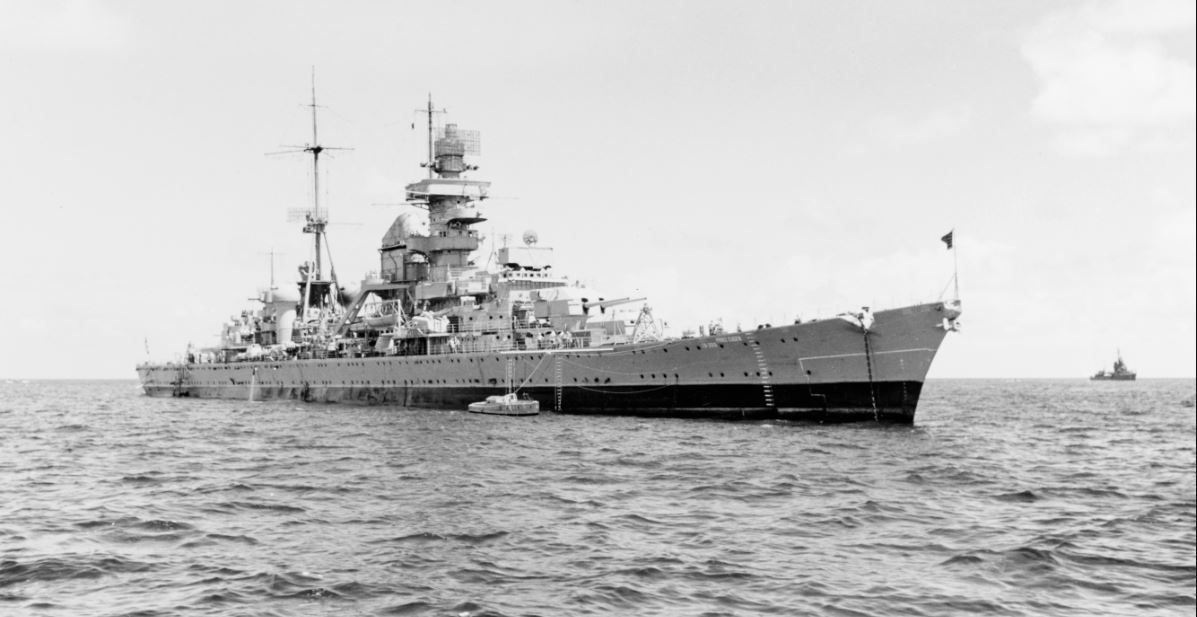
The namesake of one of Europe’s most famous military commanders lies upside down in a lagoon at Kwajalein Atoll in the Marshall Islands. Roderick Eime recalls the extraordinary life and death of this famous warship.
Escape from PNG: The Bulldog Track
Longer, higher, steeper, wetter, colder and rougher than Kokoda

How a bunch of fugitive old miners and tradesmen discovered a vital supply route and survived one of WWII great escapes.
Roderick Eime learns about The Bulldog Track from the book by actor, Peter Phelps.
The legend of the Kokoda Track has long since entered the annals of Australian folklore. The decisive and protracted battle marked a turning point in the war against the invading Japanese but, despite its unarguable importance, the Kokoda Campaign runs the danger of overshadowing many other significant battles and exploits.
Keeping Secrets – Beyond the Ramparts of the Unknown
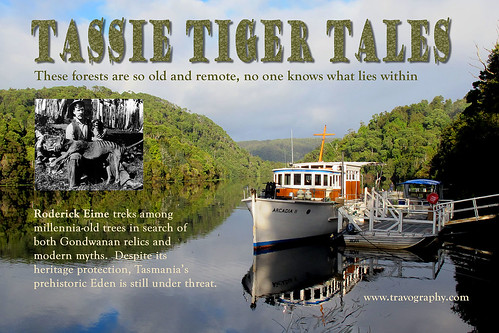
In one of the most remote corners of the planet, home to the purest water and cleanest air, live ancient plants and animals most of us will never see. But that shouldn’t stop us trying. Roderick Eime, ventures to northwest Tasmania in search of prehistoric mysteries.
Petra: Jordan’s Holy Grail
words and pictures by Roderick Eime
Described by a famous poet as “a rose-red city half as old as time”, Jordan’s Petra continues to beguile all who visit. But for how much longer?
Massive sheer rock faces, weathered by time and formed into a smooth, labyrinthine passage (siq), lead us a full mile along this ancient trading route. Two thousand years ago, traders bringing luxury goods such as incense, silk, spices and perfumes would pass through here, paying a toll to the resident Nabataeans who controlled the area.
Our caravan consists of backpack and camera-toting voyeurs, some on camels and others transported by precarious carts pulled by runaway horses. The delirious cries of over-excited tourists echo from the far reaches of the ravine, while above, some uninhibited teenager tries to perform a one-footed yoga tree on an overhanging ledge fifty metres above us. He wobbles alarmingly and the horrified crowd gasps and points in disbelief as he gathers himself up, just.
Twenty years ago, it was movie goers on the edge of their seats as Indiana Jones and his posse clip-clopped, mouths agape, into the ravine that opens up at the end of the siq. In a surrealistic reveal, the famous Al Khazneh (aka The Treasury) comes into view as we amble agog into the sunlight again.
This superb edifice is the trademark structure of Petra, impossibly ornate and painstakingly carved out of the sheer sandstone rock face. Amid a throng of leering, selfie-shooting backpackers, indolent camels and jostling tour bus hordes, we stand and gaze up at this magnificent sight. In spite of the rabble, Al Khazneh looms more than 40m above us, apparently unfazed by the milling crowd. We sit for a moment with a cup of tea bought from a ramshackle kiosk and imbibe the scene, distracted by a fragrant steaming aroma.
Amazingly, this stone metropolis sat for centuries almost undisturbed until rediscovered by Swiss adventurer, Johann Ludwig Burckhardt, in 1812. Burckhardt disguised himself as a Bedouin to infiltrate the off-limits region and stealthily made notes and sketches.
Apart from Harrison Ford in 1989’s “Indiana Jones and the Last Crusade”, T E Lawrence (of Arabia) (1914), President Barack Obama (2013), Queen Elizabeth II (1984) and King Baldwin (12thC) are among the notables to gaze on the spectacle of Petra. Pope Francis may also visit in May this year (2014).
A UNESCO World Heritage site since 1985, Petra is in fact a sprawling outdoor archaeological museum of almost 70,000 hectares, of which only 20 per cent has been excavated. At its tourism peak, Petra would host as many as 8000 visitors every day, but with the combined effects of the GFC and the so-called ‘Arab Spring’, anecdotal reports put the drop-off as much as 75 per cent.
But this lull in trampling tourists could be just what the beleaguered site needs. For several years, there have been concerns about whether the already eroded and crumbling facades can withstand much more attention. It could be a chance to install reinforced pathways and fencing to protect the delicate masonry from further damage. As 60 Minutes reporter, Tara Brown, declared “Petra is being loved to death.” *
After Petra’s appearance in the Hollywood blockbuster, visitor numbers soared. Some say by as much as ten times and the tide will surely return when the current Middle East strife abates. And if human interference wasn’t enough, the entire region is hotspot for earthquakes and many monuments have suffered under the wrath of nature as well as man.
“There’s a balance between economic and cultural value that needs to be struck,” Jordanian royal and custodian of Petra, Her Royal Highness, Princess Dana Firas, tells Brown, “Jordan needs to preserve this priceless heritage as much as we need the tourism dollars.”
Unlike her bountiful neighbours, Jordan has no oil and apart from tourism, relies on meagre export dollars from agricultural produce and minerals.
{subs: need to cut words? Cut the next two pars – 184 words}
Apart from Petra, Jordan hosts numerous other ancient natural and manmade formations like Wadi Rum, the otherworldly landscape that was the setting for the 1962 epic “Lawrence of Arabia” and described by the Welsh-born army officer as “vast, echoing and god-like”. Today, visitors can camp in the desolate valleys, embark on Bedouin camel treks and even take a dawn flight in a hot air balloon.
Then there’s the Dead Sea, less than 50 kilometres from the capital Amman and the lowest point on the surface of the Earth at -400m. The fabled inland body of water is also facing its own threats as its source, the Jordan River, has been diverted by Israel. Millions of tonnes of minerals like potash and bromine are extracted from the water annually by both Israel and Jordan and the water level is falling rapidly. While the going remains good, thousands of visitors staying at such plush resorts as the 5-star Kempinski Hotel Ishtar Dead Sea enjoy the therapeutic and healing qualities of the water and mud known for its remarkable properties as far back as Aristotle (c.350 BC).
But the ornate, parched and abandoned realm of the ancient Nabataeans remains the struggling kingdom’s major drawcard and while most ‘tick box’ visitors spend less than a day within the confines of The Petra Archaeological Park, a comprehensive exploration would take several. Climb 1000 stairs to reach the fabulous ‘monastery’, at least double the size of the ‘treasury’ and something of discovery in itself. Then there’s the amphitheatre, the museum, the royal tombs, the great temple and the staggering Byzantine Church with its intricate mosaics.
That same poet, John William Burgon, a 19th century clergyman, concluded his verse with the lines:
It seems no work of Man's creative hand,
by labour wrought as wavering fancy planned;
But from the rock as if by magic grown,
eternal, silent, beautiful, alone!
Silent and beautiful certainly, but while these hand-hewn rocks of ages still stand, it’s the modern swashbuckler, Indiana Jones, who has set the tone for Jordan’s Holy Grail.
Go2
Emirates, Etihad and Qatar Airways provide convenient connections to Amman (AMM) from Australia. Cruise passengers can also visit Petra via shore excursions from Aqaba.
Petra is located 262 km south of Jordan’s capital, Amman. Park entrance fee is 90JD (AU$140) for visitors not overnighting in the town. www.visitpetra.jo
Best time to visit is spring (March to May) and autumn (September to November).
Stay: Mövenpick Resort Petra is located opposite the entrance to the park. www.moevenpick-hotels.com
Eat: Classes in Jordanian cuisine at Petra Kitchen www.petrakitchen.com
For more information on travel to Jordan, see www.visitjordan.com
The writer was a guest of Jordan Tourism Board
Breakout Factoids:
The name ‘Treasury’ was coined from the misguided belief that the structure contained a pharaoh’s treasure. Bullet-ridden sculptures bear testament to locals’ attempts to break open the mythical cache.
In 2007, Petra was voted into in the controversial New Seven Wonders of the World along with the Taj Mahal and Colosseum. Petra received a reported 14 million internet votes, twice the population of Jordan.
* http://sixtyminutes.ninemsn.com.au/article.aspx?id=8748047
Ice Would be Nice
A changing climate has turned the treacherous Northwest Passage into a pushover, discovers Roderick Eime
We’re crowded on the bridge, at least 20 of us, peering out to the horizon with powerful binoculars and telephoto lenses. Surely we’ll see something soon.
Polar bears, whales, countless seabirds and even a rare species of Caribou are all checked off, but something is still missing up here in the high Arctic of Nunavut, Canada. It’s ice.
Up until the last decade, the Northwest Passage was only achievable, if at all, during a small window of opportunity in the northern summer when favourable winds and currents allowed a narrow corridor through the pack ice. The first person to successfully navigate a vessel through the labyrinth was Roald Amundsen in 1906 – a feat that took him the best part of three years.
Beginning almost 200 years ago, scores of brave (some say foolish) explorers set off in waves in an attempt to claim the 20,000 pounds reward offered by the British Admiralty for the discovery of a North-West (sic) Passage. Early attempts were conducted in unusually low ice conditions and bore promising results, but by the mid-19th century, the ice had rebounded and efforts culminated in the famously disastrous expedition by former Tasmanian Governor, Sir John Franklin, who vanished along with his 128 men and their two ships.
Now here we are aboard the Akademik Ioffe, a well-travelled and sturdy former Soviet polar research (some say ‘spy’) vessel steaming confidently through the narrows of the Bellot Strait, a notorious little sliver of water that thwarted almost every navigator before us. The chap who named it in 1852 actually had to the sled the whole way on ice and it wasn’t traversed by a ship until 1937. Some of our complement is actually aboard a little Zodiac runabout for the 25 kilometre run, stopping to set foot on the northernmost point of the American continent, Zenith Point at 72 deg N.
Prior to this, we’d been way up at 74 degrees on Beechey Island, the site of Franklin’s winter camp and burial site for three of his early casualties. This rocky appendage to the much larger Devon Island serves as northern gatekeeper to the east-west Parry Channel. These graves are the only contemporary memorial to Sir John Franklin’s famous folly. From forensic examination of the well-preserved bodies in the 1980s, it was found they succumbed to a mysterious combination of lung disease and lead poisoning thought to be from poorly soldered cans of food. Numerous other memorials and a now ruined winter refuge were added in later years.
“Ice at two o’clock, and what’s that? A bear?” comes the call from Boris, our patient and vigilant expedition leader. At the exit of the strait we finally encounter the ice he’d been studying the night before on the daily satellite chart and there, through the strongest binoculars, we see a lonesome but very large male polar bear, nostrils aloft, already sniffing us out. Given we are something like a day ahead of schedule because of the effortless, ice-free journey so far, Boris decides we’ll keep the bear company for a bit.
The following day is a similar doddle south down through Larsen Sound and after a hearty lunch of steaming broth and roast lamb, we go ashore at the triumphant-sounding Victory Point. In truth, there's nothing victorious about Victory Point. Named, not after some long-forgotten battle, but after the ship commanded by Capt. John Ross during his arduous 1830 voyage.
We land on a desolate and rocky shoreline in our well-rehearsed procedure where shotgun-toting scouts disembark ahead of the main group to set up a polar bear perimeter. After the abundance of hungry carnivores sighted at Coningham Bay, there's plenty of reason to be cautious.
Dotted along the ridge above the high water mark are several stone cairns erected to attest the arrival and departure of various vessels and their shore parties. None, however, are likely to be the original cairn built to mark the initial progress and later demise of Franklin's last surviving men who suffered, as searcher John Rae wrote in his 1853 report to the Admiralty, "a fate as terrible as the imagination can conceive."
None of the monuments we examine contain any clue to their origin. Some weathered mahogany once fastened with modern stainless screws and some soggy, illegible scraps of parchment are all that remain of previous visits. But it was here that the famous official Admiralty document was found in 1859 bearing definitive news of the fate of Franklin.
The document's first entry was on 24 May 1847 signifying 'all well', but further messages scribbled in the margins told a much gloomier tale, including the death of Franklin himself just two weeks later.
It read in part:
April 25th, 1848. Ships Erebus and Terror abandoned ... Total loss by death to date, 9 officers and 15 men ... Start tomorrow for Back's Fish River.
Despite a forensic examination of the puzzling remains by the search party, the mystery of the Franklin Expedition's demise remains unsolved. But as far as the Admiralty was concerned, the costly expedition was lost and the 'case closed'.
Our journey ends as Franklin’s should have at the unlikely outpost of Kugluktuk, an Inuit settlement almost to the Beaufort Sea where a vintage 737 is sent to collect us and bring new adventurers for the return journey. As the old jet taxis through a cloud of dust to the ramshackle terminal, I try to imagine those wretched souls man-hauling heavy lifeboats and scavenging anything to survive in the harsh, featureless landscape of the Arctic. If only they’d waited 150 years, they could have done it in a canoe.
Go2
GETTING THERE: Air Canada (www.aircanada.com) flies daily from Sydney to Vancouver and directly onto 59 Canadian cities. One Ocean Expeditions provide connecting charters from Ottawa and Edmonton.
STAYING THERE: The historic Fairmont Chateau Laurier, Ottawa. (www.fairmont.com) has rooms from around A$250/night. TripAdvisor 4/5.
CRUISING THERE: One Ocean Expeditions (www.oneoceanexpeditions.com) offer two annual 14-night Northwest Passage expeditions aboard the 100-berth Akademik Ioffe in August between Kangerlussuaq (Greenland) and Cambridge Bay (Canada). Enquiries: Active Travel (www.activetravel.com.au) 1300 783 188
Wales: Welsh Revhead
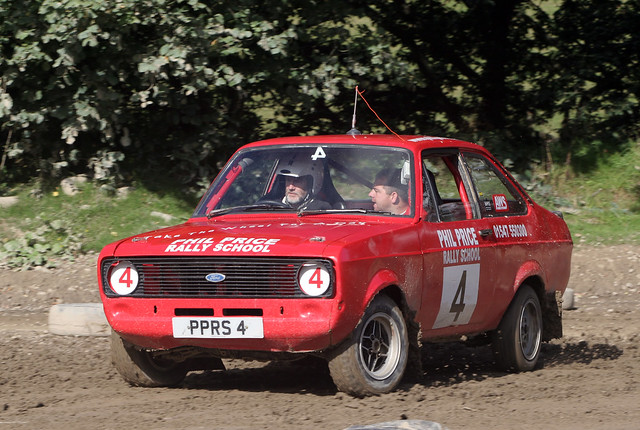
Hiding among the idyllic Welsh countryside is a notorious school for boys and girls.
Phil was a lousy tour guide. Here we were in the gorgeous green dales of Wales and what was I going to see at around 200 km/h? Mighty trees, a mere metre or so from my door handle were an unseen blur and I never even saw the hundred metre drop barely an arm’s length away. The little Ford Escort coupe had rock-hard suspension, very poor noise insulation and was caked in thick dirt. But I asked for it.
Phil Price is one of the UK’s top rally instructors. Located in the lush, picture-postcard hills of Wales, about 50 miles west of Birmingham, Rally HQ is a modest demountable under a giant oak tree and full of photographs, trophies and model cars. Phil caught me staring at a shot of a 1980s-era Mk.II Escort at full noise. I thought I recognised the vivid yellow helmet behind the wheel. “Yep, that’s Ayrton Senna. He loved it here.” Many of the world’s top rally teams use his vast forest facility for pre-event and off-season testing, but I’m here for day of “hands on” tuition in this knife-edge sport.
Wales has proud rally heritage and is the current host to the oldest regular international rally event, Rally GB. Now branded Wales Rally GB, the Welsh Government is underpinning its support of the event with an impressive economic promotion. Despite the unforeseeable and premature termination of the 2005 event, Wales have committed to support the event until 2011, reinforcing the broad public and governmental backing.
Meanwhile, back at Phil’s, ten of us gather around in the “briefing room” for a run-down of the day’s activities. Scanning the motley assemblage, his quiet, laconic demeanor belies the intensity behind sharp, steel-blue eyes. A dignified, albeit minimal coiff of grey hair frames his lean, chiseled features. There are the inevitable “hey-day” anecdotes, near death experiences and “there I was” tales related in a straightforward, matter-of-fact manner.
Phil is refreshingly light-on for whiteboard coaching and bureaucracy and we’re soon revving up for our first laps of his artificially muddied, kidney shaped circuit with all the traction of an ice rink. It’s pretty evident from the get-go that none from this batch of freshmen are of the calibre they imagined with numerous tail-slides, understeers and plain ol’ balls-ups.
Despite our impressive and comprehensive array of driving violations, our instructors (one of whom is female) are sympathetic and delightfully non-judgmental, thereby preserving our fragile male egos in the face of abject devastation. No “sergeant major” debasement required – we were doing just fine on our own.
Just when we thought we were getting the hang of it, out would come the water truck to deal us another hand of wildcards. In spite of all earlier predictions, our cumulative skill pool appeared to rise. Wild ‘tailies’ were tamed, throttle feet were unleaded and white knuckles turned to pearl.
Then, after some lunch, Phil calmly announced we were all going to have a steer of his AWD Turbo Cosworth Escort on the forest stage with him calling the notes. Talk about in the deep end.
Despite my own attempts at psychological desensitisation, the process of strapping into a full-blown (pun intended) rally car is highly intimidating. Helmet and microphone are installed and Phil’s voice, complete with signature Welsh accent, came across the invisible headphones in a barely intelligible stream of crackles and Cymraeg.
I don’t notice the speed as I attempt to hammer up the rocky hill toward the hairpin, engine struggling to stay on the power. What I do notice is the wholly incredible traction in this little car and I sense a glow of confidence as we slip noisily between the trees, Phil’s excited chatter still hissing in my ears. Fortunately, the route is fairly self-explanatory; this way road, this way trees and pain.
“Go right! Go right!” Phil yells when the car clearly wants to go left. I gather it up inelegantly and continue to the finish, my upper arms and shoulders protesting at the unusual exertion. Phil looks me plainly in the face, “not bad”. So ends my assessment.
 As the racks of the initiated continue to grow, smug satisfaction spreads amongst us like teenage debutantes. And as a grand finale and effective quench for our conceit, Phil unveils his secret weapon, another Cosworth Escort, only this time rear-wheel-drive and, according to Phil, “much more fun!” One-by-one, we’re installed as mute navigators and hurled around the same forest stage at roughly twice the speed. As we’re extricated, breathless and quivering, our day is complete. Trophies, for what I don’t know, are distributed and we depart knowing that, while we’re never going to steer like a real rally driver, we’ll never lose out on another parking spot at Coles!
As the racks of the initiated continue to grow, smug satisfaction spreads amongst us like teenage debutantes. And as a grand finale and effective quench for our conceit, Phil unveils his secret weapon, another Cosworth Escort, only this time rear-wheel-drive and, according to Phil, “much more fun!” One-by-one, we’re installed as mute navigators and hurled around the same forest stage at roughly twice the speed. As we’re extricated, breathless and quivering, our day is complete. Trophies, for what I don’t know, are distributed and we depart knowing that, while we’re never going to steer like a real rally driver, we’ll never lose out on another parking spot at Coles!
Doing It:
A Royal Rendezvous with the King of Coron
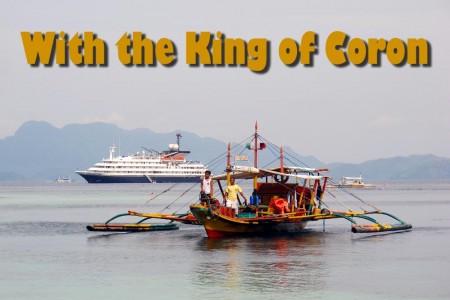
Coron
A Royal Rendezvous with the King of Coron
The mini monarch of a tiny Filipino enclave could have some lessons for the world. Words and images Roderick Eime.
“Yes your majesty, everything is arranged. No, thank you your majesty, we have everything we need.” And with that, Orion expedition leader, Justin Friend, flipped his Nokia shut and breathed a sigh of relief. We are about to meet His Royal Highness HM Tribal Chieftain Rodolfo Aguilar I in his ancestral kingdom, the island of Coron.
Orion II has just dropped anchor in the narrow straight between Busuanga Island and its lesser satellite, Coron, in the Sulu Sea about 300km SSW from Manila. It’s a wild part of the Philippines for sure, inhabited by the northern (or Calawian) Tagbanua people who are quite possibly the oldest ethnic group in the entire Philippines.
Despite his miniscule dominion, HRH Rodolfo is not a monarch to be trifled with. Together with his Council of Elders, he obtained a Certificate of Ancestral Domain Title for his people in 1998, a Native Land Title by any other name. In the hotbed of Filipino politics, that’s no mean feat and it means he has all-but-absolute rule over this ethnic enclave that includes not only the rugged limestone islands, but also the much prized fishing grounds.
Perched on the gunnels of our Zodiac tenders, the floppy-hatted delegation motors toward a secluded beach on Coron Island, just out of sight of the main township across the strait on Busuanga. Our landing site is a sheltered cove overseen by towering basalt cliffs splattered with gnarly outcrops of awkward-looking shrubs clinging to the sheer walls.

The stern of the sunken Japanese WWII freighter, Olympia Maru near Coron, Philippines. (c) Capt Peter Heimstaedt
During the Second World War, these craggy alcoves hid warships and transports of the Imperial Japanese Navy as they made the treacherous voyage between Japan and the battlefronts of Borneo and Papua New Guinea. With the Allies on the front foot in the closing months of 1944, twelve ships laden with urgent supplies for the beleaguered Japanese forces were located by Allied aircraft and promptly sunk at anchor. This ‘ghost fleet’ of Coron is now one of the world’s best locations for wreck divers and little dive shops dot the main street in town catering to the constant trickle of aquanauts arriving from all over the world.
Mostly stripped of their valuable contents by post-war salvagers, the bare hulks are easily explored by divers of modest ability in depths of around 25 to 30 metres. Colourful marine organisms have attached themselves to the rusting relics while batfish, stone fish, barracuda, lion fish - and scores of others whose names I've never learned - patrol the decks and open holds where doomed Japanese seamen once fought to defend their vessels from dozens of dive bombers.
As our tiny flotilla approaches the delicate little beach, we can see all is in readiness for the royal occasion. Makeshift picnic shelters and benches festooned with local flora await our bottoms while local villagers bustle about with last-minute preparations. Unloaded and ashore, we gather in anticipation as HRH prepares to greet us. Meanwhile, Justin, who spent weeks in the region organising this regal occasion addresses the gathering.
“This is really quite a special occasion,” he begins with uncharacteristic restraint, “we are the first cruise ship to visit the kingdom of Coron and it is with the blessing of His Royal Highness that we are here enjoying this magnificent location.”
Justin proceeds to make a theatrical sweep of his arm, symbolically embracing the gorgeous bay, its aggressive basaltic grandeur and all who camp within. I get the feeling he’s been rehearsing this moment. And with this none-too-subtle cue, an unassuming gentleman breaks from the ranks of the locals and steps forward to address us. No mink or ermine nor pearled crown, King Rodolfo’s regal accoutrements extend to a clean, collared polo shirt adorned with a delicate yellow scarf and crisp denim shorts. A pair of well-worn blue Crocs completes the ensemble.
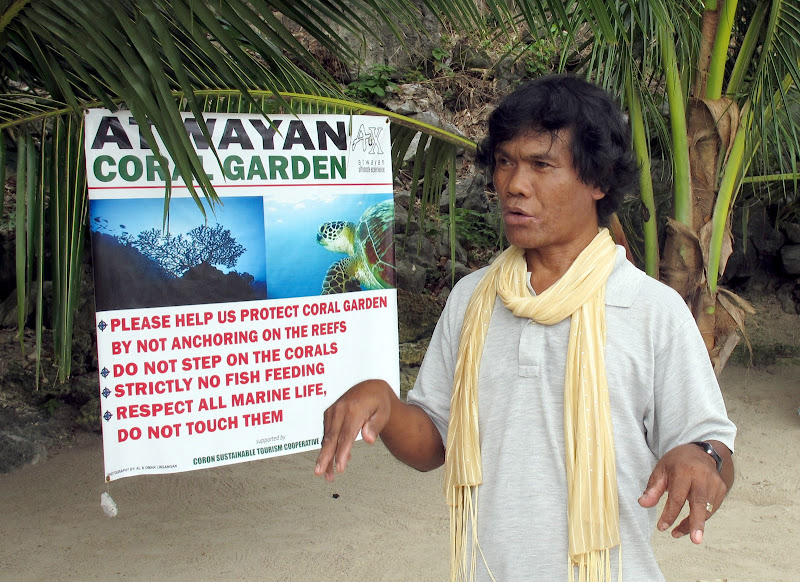
His Royal Highness HM Tribal Chieftain Rodolfo Aguilar I
Through an interpreter, his majesty greets us and we join him in a short prayer. The Tagbanua people are nominally Christian although adherence to traditional rituals and beliefs is strong. They have their own distinct language and even a unique script, but those with the knowledge of the ancient tongue are dying out.
With the solemn ceremony over, the gathering is treated to a display of traditional Tagbanua dance. It’s raw and rudimentary without lavish props or production, but the significance is not lost. The courting dance, or segutset, in particular, is unmistakable and Justin looks like he may be spirited away into the jungle at any moment by a particularly enthusiastic female member of the tribe. While his subjects quickly dispense with formality and embrace us in the festivities, King Rodolfi maintains an aloof air as he taps rhythmically on a skin drum. He is king after all.
The imposing basalt cliffs that protect us from the blazing sun also provide a valuable resource for the Tagbanua: swift nests. These tiny birds nest high in the cliffs in little nooks and on ledges 100 metres and more above us. One athletic young man, eager and proud, climbs the sheer walls as we look on holding our breath. Barefoot and clad only in a flimsy pair of shorts, he clambers vertically to an overhang from where he throws us a cheery wave.
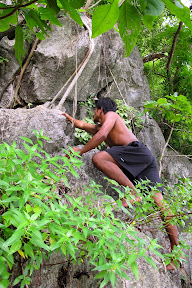
A young Tagbanuan man scales basalt cliffs on Coron Island to retrieve swift nests for birds nest soup
Swift nests have been used in Chinese cuisine for hundreds of years and a kilo of saliva that forms the little birds' nests can be worth up to $10,000. The king, therefore, is mindful of potential disturbance to his fragile resource and tourism like ours is cautiously welcomed as long as it doesn’t impact on his hard-won cultural and economic independence.
After a day of lazing in the opal hued waters around Coron and a visit to Kayangan Lake just next door, reputedly the cleanest inland body of water in the Philippines, the party moves back onto Orion II. Our Coron cultural liaison and local eco-hero, young Al Linsangan, musters his minstrels on the rear deck and enthrals the dinner guests with a hauntingly soulful repertoire of local rhythms set to modern electronic instruments.
As the well-relaxed diners tap their feet to Al and his troupe’s cheery ballads, I can’t help feeling he’s singing a song of optimism and hope. Will the tiny Tagbanua community thrive or shrivel in the gaze of global tourism. I put that thought aside for a moment and sing along.
END
Orion II returns to Coron in 2012 as part of their Yangtze, Ryukyu and Philippines itinerary departing Shanghai 11 July. The 15-day expedition includes stops in Japan, Taiwan and Borneo. Fares start from $10350 per person. Refer to your travel agent or Orion Expedition Cruises for any discounts applicable.
www.orionexpeditions.com Toll Free Australia: 1300 361 012
For information on tourism in Coron, see www.corontourism.info
Niue: Stalking the Giant Uga
Niue for AAP
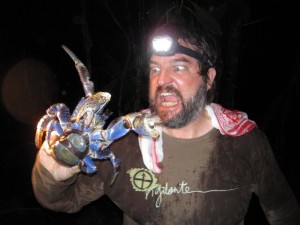
On a tiny Pacific Island, man still hunts to survive. Roderick Eime, goes in search of a real prehistoric monster that still haunts the Polynesian rainforest.
The uga (pronounced OONG-a) is not to be trifled with. It is a truly hideous beast that lives deep in the damp Niuean tropical forest and is the source of legend, rumour and folklore. Its claws, like deft mechanical pincers, can easily dismember a human in a blink and its demeanour is nothing short of monstrous. It is the world’s largest terrestrial arthropod.
It’s close to 9pm as we huddle with our guide Tony Aholima in a picnic shelter at Mutalau as a rain squall passes across the top of the tiny island nation of Niue (pronounced NOO-ay). Four of us are preparing to venture into the dense undergrowth in pursuit of this creature and Tony carries a large empty rice sack into which the captured beasts are to be flung. “We’ll get a big one tonight, I’m sure,” says Tony with a gleeful look that belies the impending danger.
Two days prior, we set traps along an overgrown rocky path designed to lure the uga from its lair in the jagged coral rock that is the substrate of the entire island. The traps, thankfully not maidens pegged to tree trunks, but simply ripe juicy coconuts split open and wedged into the crevasses - irresistible to the ravenous nocturnal hunter.
Niue, known in South Pacific circles as the "Rock of Polynesia", is just 259 sq km and perhaps the smallest nation in the world with just 1500 residents, although another 15,000 ‘nationals’ live throughout the Pacific, mainly New Zealand. Despite its size and population, Niue punches above its weight in both sporting and cultural circles. The men, lean and fit, are renowned rugby players, while the women dominate the region’s beauty pageants such as the coveted “Miss South Pacific” where they have captured the title twice in the last five years.
Located 600 kilometres northeast from Tonga, Niue enjoys a relaxed and unhurried pace that is laid back even by Pacific standards. The impeccably groomed and spotless communities are a far cry from some of their islands neighbours and the rich diet of fish gives Niueans a long healthy life. There are no mobile phones and I’m told the first ATM is on the monthly supply ship due next week. There’s free Wi-Fi though.
Sustainable tourism is not a token cliché on Niue, it is a necessity. With limited natural resources and hotel beds, tourism forms a delicate but important thread in the fabric of Niuean life. Air New Zealand flies in and out just once each week with a 152-seat A320, upped recently from a 737, but more capacity is being sought and a second flight, possibly via Tonga, is being negotiated. Visitors come to enjoy the superb scuba diving and snorkelling, where whales and dolphin encounters are more often than not, deep sea fishing (just a few hundred metres off shore), nature walks and the famed uga hunting.
Enough team talk, it’s time to set off on the hunt. We don LED head-torches and creep into the dark forest as fat rain drops catch our beams and create a dazzling curtain through which we walk. Barney the wonder dog, trots noisily by our side while the percussion of the heavy drops on the big leaves creates a sinister soundtrack. Suddenly there’s a loud crash behind me and an unprintable curse. I spin around expecting to see fellow hunter, Nick, in the jaws of an uga. There’s blood, but he’s just slipped on the slimy path and grazed himself. The casualties begin, but we press on.
“Wait here,” whispers Tony loudly, and he ventures ahead as we all crane for a look. “Come!” He signals to me with a vigorous hand gesture and shines the torch towards the coconut we laid out before. Sure enough, one of the creatures has succumbed to temptation and is perched menacingly on a pile of husks. Tony draws breath between clenched teeth, “I told you we’d see a big one!”
Tony moves in and the bright purple animal, alerted and on the defensive, rears up with its fearsome claws ready to remove any accessible appendage. But Tony is too quick; he lunges and snatches the beast behind the neck hoisting it up triumphantly. Young sisters, Tess and Elsbeth, squeal as much in delight as fear, but before the angry crustacean is secured in the sack, the victorious hunters pose for photos.
The uga, Birgus latro, is also known commonly as the coconut or robber crab and still lives in sufficient numbers on Niue to allow careful harvesting. Looking ominously like the dreaded face-hugger from Ridley Scott’s Alien movies, it is also common but protected on Christmas Island in the Indian Ocean, their populations are delicate elsewhere. While our prize is about the size of a football, specimens up to one metre across and over ten kilograms have been recorded.
Soaked to the skin, but satisfied in our haul of the grotesque delicacy, we pile back into Tony’s ute. “C’mon Barney, curry time!”
IF YOU GO
GETTING THERE,
Air New Zealand flies weekly from Auckland each Friday morning. (Flight NZ784) www.airnewzealand.com
STAYING THERE
The premier accommodation offering is the Matavei Resort but there are several more modest lodgings available too. See www.niueisland.com/hotels/ for details.
PLAYING THERE
Niue offers excellent scuba diving, fishing, nature walks and caving. Try a vaka (outrigger canoe) paddle or snorkel. A range of café-style restaurants are in the main town at Alofi and a 9-hole golf course is adjacent to the airport.
For details of all activities, tours and travel, see www.niueisland.com
Poor ‘Pistoff’: 70-year mystery solved

Beneath the waters of PNG's Collingwood Bay, Roderick Eime helps solve a lingering mystery.
The battered plane had brought them this far, enough to escape enemy territory, but now the flight was over. Riddled with bullet holes, one engine out and no fuel, 26-year-old US Army pilot, Lt. William 'Casey' Lett from Indiana scanned the coastline for smooth water.
The flight to Lae was, for the crew of B-25 41-12830, ”Pistoff”, a nail-biting bomb run on Japanese troops unloading in Lae and they had copped a spray of fire from five defending Zero fighters. On half power, they couldn't cross back over the towering Owen Stanley Ranges to Moresby and instead headed east along Papua New Guinea's ragged coastline in search of safe haven.
“We're going in!” called Lett and the five men held on and drew what might be their last breath. With wheels up and the remaining prop feathered, they hit the water as delicately as Lett could manage. Amid a gut-wrenching din of tearing metal and shattering plexiglass, the nose caved in and a huge spray of water engulfed the plane. Apart from bombardier, Gus Rau, who had struck his head, all were mercifully uninjured. With water pouring in, the men managed to get to their raft but villagers from nearby Ayuwan were already paddling to their rescue.
Thanks to the villagers and a small group Australian troops camped nearby, the crew of “Pistoff” all found their way back to base. But the poor plane's war was over and in just five minutes she'd settled into a watery grave.

Fast forward 65 years and Sebastian from Ayuman is chasing turtles in the silty water off his little village. As a big turtle flees his spear, Sebastian notices the shape of a plane in the depths. The story of the crash and rescue has been forgotten over the decades and the find is reported to US authorities. After sifting through wartime records of the 38th Bomb Group (The Sunsetters), officials are reminded that the precise whereabouts of 41-12830 remain unknown. "Somewhere near Buna" reads the record, some 200kms west of our search.
Now I'm on my own little mission, bouncing across the choppy waters of Collingwood Bay en route to Ayuman in a runabout with dive crew, Archie and Alex, from nearby Tufi Dive Resort. The few remaining veterans from the 38th Bomb Group Association are keen to fill the gaps in their records and I'm tasked with positively identifying the wreck by locating one of the few serial codes on the aircraft that can conclusively rule off this chapter.
We're met by Sebastian and a small flotilla of canoes who gather about us curiously while Alex goes below to secure the boat. As finder of the wreck, Sebastian is now its custodian and I've already been made aware of the villagers' intention of vigorously preserving it. Luckily Sebastian is Archie's bother-in-law and the discussions, while earnest and businesslike, are positive.
A bright orange divers' 'sausage' pops to the surface and we're clear to go down. The water is murky and dark from the recent heavy rain and slowly the shape of the Mitchell bomber reveals itself. First the upper gun turret with its two 50 calibre machine guns, then the cockpit and finally the rest of the fuselage and signature twin tail. I'm deliberately diving with a lightened belt to keep me off the silty bottom and I begin picking over the forward part of the fuselage with my fins hovering above me.
The aluminium surface is completely covered by military-grade algae with layers of marine growth on top. Like cars, all aircraft leave the factory with a stamped plate showing model and serial numbers and our search for it is proving frustrating. I send slightly built Archie into the cramped fuselage and he starts handing me back all kinds of loose items; a Grimes Model K-8 hand-held searchlight, a Stanley Super Vac flask and a clip with five rifle bullets. We bring these to the surface to show Sebastian, change tanks and take some photos.
As I haul myself into the boat, Sebastian hands me a barnacle-encrusted metal box. It's clearly a piece of radio equipment one of them had salvaged well before our arrival. An ID plate is affixed to the top of the box and I scrub away at the growth to reveal its purpose. Radio Control Box, Bendix Corporation, Signal Corps US Army and ... wait .. what's this? A serial number is hand-stamped into a little panel; '5052'. Each aircraft has a unique identifier on their radio and this will be enough to confirm 'Pistoff''s true identity. Archie hauls anchor and finds to our great amusement that Alex had tied the rope to a loose 30 Calibre machine gun lying next to the wreck, part of the debris from the destroyed nose section. After some fun and photos, we return all items to the wreck and head home.
Nearly 70 years on and Papua New Guinea is still reluctantly giving up its war secrets. Crashed aircraft, sunken ships and the remains of MIAs are still being recovered to this day.
Tufi Dive Resort in Oro Province is perfectly located on the tip of a glorious tropical fjord. Itself a wartime PT boat base with its own history and artefacts, it is one of PNG's best-known dive locations with access to numerous pristine coral reefs and wrecks including the well-documented B-17 Flying Fortress, Black Jack, lying at 45m across Collingwood Bay. Lonely 'Pistoff', forgotten for over half a century, now joins their repertoire of dive sites.
Tufi is also famed for its brilliant cultural experience. Local villagers engage goggle-eyed visitors with vivid displays of dance, ritual and ceremony at least on par with anything else in the country. The coastal residents of this wild land are ethnically diverse from their highland cousins and separated by hundreds of unique languages and rites. Handsome, polite and gentle, well-organised tourism is critical in helping these people maintain their colourful traditions which they delight in sharing with their mesmerised guests.
The author wishes to thank Tourism PNG, Tufi Dive Resort, the men of the 38th Bomb Group Association and Justin Taylan of pacificwrecks.org for their valuable assistance in solving this mystery.
Doing It:
Tufi Dive Resort is located in Oro Province and a short domestic flight from Port Moresby. Rates begin at A$145 per person twin share per night including all meals. Activities include cultural shows, deep-sea fishing, kayaking, trekking, snorkelling and scuba diving. (Extra cost) www.tufi-experience.com
Further information:
www.sunsetters38bg.com
www.pacificwrecks.org
www.tufidive.com
www.pngtourism.org.pg
PNG: First Contact
alternate title: The Golden Wahgi
When gold was discovered in the highlands, it brought a million people into contact with the rest of the world. Roderick Eime traces the history of that first contact.
“The whiteman came from there,” said the old village elder gesturing toward the end of the valley, ‘we’d never seen such a thing. We were scared, confused.”
This scene played out time and time again as the Leahy brothers and their caravan of trackers and porters made their way to the unexplored inland in search of gold.
There were hints of gold lying in and around Papua New Guinea as far back as the mid-19th century and each new find was accompanied by a flurry of activity, but it wasn’t until 1926 that large commercial quantities began to be excavated by modern machinery. Even then, it wasn’t enough and exhausted diggers soon returned to Australia to join the growing lines of jobless as the Great Depression took hold.
Michael James “Mick” Leahy, born at Toowoomba in 1901, was no ordinary man, even among the hardy Australian bushmen of the time. Always rough and ready, “Masta Mick” as he would later be known, began a dynasty that persists to this day.
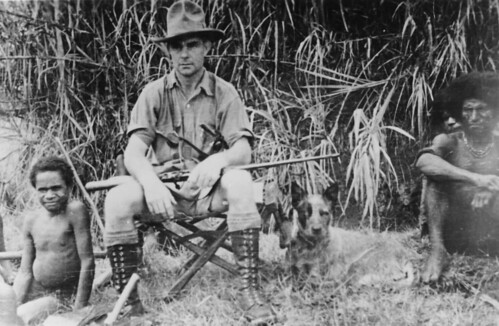
Mick Leahy in PNG
In 1930, Mick, along with fellow prospector, Michael Dwyer, began a series of prospecting trips into the interior beginning with the Ramu tributaries and culminating in the now famous discovery of the Wahgi Valley around today’s Mount Hagen. By this time Mick’s brothers, James and Daniel were well entrenched in the business, following him everywhere.
“They say Mick had the gold fever,” recalled Dan during the making of the 1983 Academy Award-nominated documentary ‘First Contact’, “well, we all had it.”
Sure, they found gold and lots of it, but Mick was also interested in documenting the discovery of the million or so previously unknown inhabitants of these vast, fertile valleys. His explorations grew more audacious and, after a few violent encounters, learned to travel well-armed and provisioned. He also took cameras.
“When the white man thought our leader was going to attack, he shot him,” recalls the same villager as he recounts that event to the filmmakers.
“The only reason we killed was to defend ourselves and all our carriers,” says Dan in defence of their actions,” if we hadn’t they’d have killed the lot of us.”
The documentary, made by Sydney filmmakers, Bob Connolly and Robin Anderson is a fascinating recounting of the heady days of prospecting and discovery in the wild highlands of Papua New Guinea. Hours of Leahy’s 16mm film were recovered and restored and then the crew returned to the Wahgi Valley and found surviving members of his expeditions and villagers who remember their first confrontations with these strange white ghosts.
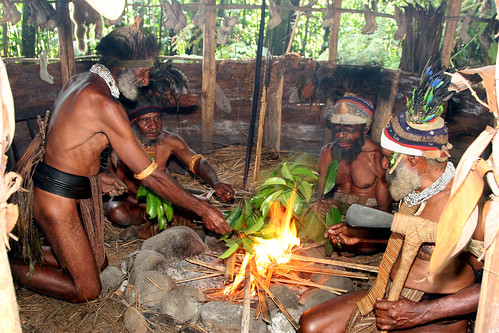
Melpa men of the Tokua village near Mt Hagen, Papua New Guinea perform a moka where they exchange gifts and confer on village matters.
Today visitors to Mount Hagen and the surrounding valleys will meet people who, just two generations ago, were completely unknown to the outside world. While comparisons to the Leahy brothers’ empire might be regarded as overly flattering, Newcastle entrepreneur, Bob Bates, has created his own minor dynasty with Trans Niugini Tours.
For over 45 years, the Bates family have lived and worked in Papua New Guinea with their head office on the original site in Mount Hagen. Their network now extends beyond the initial modest 4WD safaris, to aircraft charters, wilderness lodges and river cruises. Son, Andrew, handles the company’s marketing and travels back and forth from the family property near Newcastle.
“Dad’s a bit shy really,” he notes with a wry grin and nods toward Bob who ducks out the back door, “but he’s got lots of stories to tell.” I’m sure! Bob is a regular around town and still drives an original Range Rover he bought new in the ‘70s.
Although I spend one night at the centrally located Highlander Hotel in downtown Mt Hagen, the remainder of my stay is at the superbly located Rondon Ridge, a new Bates family lodge overlooking the entire Wahgi Valley, or so it seems. Spacious and intriguingly decorated with Highland and Sepik art, it is powered by its own hydroelectricity plant and the kitchen serves organic salads and vegetables gathered from the many local market gardens. The avocadoes are to die for.
The Wahgi Valley is the domain of the Melpa people and their unique language is heard in the villages, markets and busy bus stops around town. PNG has over 800 unique languages, a legacy of its millennia of isolation and territorial nature of the many tribes. Even Leahy’s Papuan men had no way of communicating with the Melpa during their historic first encounters and everything was negotiated with sign and body language.
“If we wanted a pig for dinner, we’d grunt ‘oink, oink’ like that,” said Toa, one of Mick’s ‘boys’ to the camera, “and we’d buy the pig with shells.” The Melpa had never seen shells and they instantly became currency and were negotiable for all manner of goods ... and services.
Joseph, my driver and guide, takes me on a series of jaunts throughout the region visiting villages, gardens, markets and points of interest like the Gatak River, where the Leahy brothers found much of their gold.
“My father found a big nugget for Masta Mick,” recalls Joseph, pointing over to the river. Joseph’s dad was just a boy then, working for the Leahys.
Villagers in traditional attire demonstrate their ancient methods of agriculture, planting and harvesting. We’re invited to try roasted sweet potato and it’s delightful. The Wahgi Valley is now recognized as one of the first areas of human farming, dating back 9000 years and the Kuk Swamp site is UNESCO World Heritage listed.
The lodge also has a series of walking trails into the surrounding forest. Its secondary growth apparently, regenerated after Australian loggers came through and cleared out all the oak and beech in the ‘50s. Joseph shows me through the lodge’s orchid garden, protected by a moat from marauding pigs. It is their goal to collect every orchid that occurs in the valley, about 400, and they’re half way there now.
Mount Hagen is world away from the even the rest of Papua New Guinea, with obvious genetic differences between the coastal inhabitants. A visit there will help you understand the exhilaration experienced by Mick Leahy and his team who discovered both alluvial and cultural gold in the mist-enshrouded peaks of the Wahgi.
If you go:
Trans Niugini Tours [www.pngtours.com] offer an extensive range of tours and excursions throughout Papua New Guinea. +675 542 1438 service@pngtours.com
[as supplied] Getting there: Pacific Blue offer flights from Sydney to Port Moresby (connecting via Brisbane) with fares starting from $319 per person, one way on the net. Direct flights are also available from Brisbane on Mondays, Wednesdays, Fridays and Sundays from $239 per person, one way on the net. If you're looking to keep entertained, simply hire the digEplayer. Your own personal in-flight system features movies, TV shows and a board array of music for an additional $20. If you fancy extra leg room, book the Blue Zone seating option for an extra $45. Check out www.flypacificblue.com for current specials, bookings and all your travel needs.
Both Air Niugini and Airlines of PNG fly daily to Mount Hagen.
Best time to visit: Mount Hagen Show is a cultural feast staged every August.
Further reading: “First Contact” available on DVD by Arundel Films